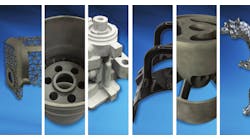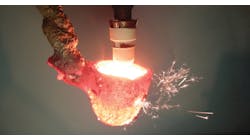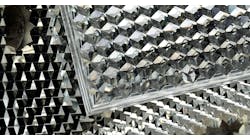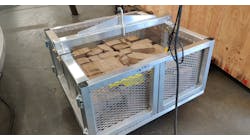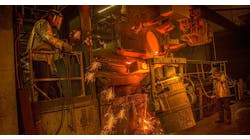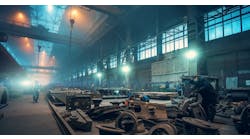Ducitle iron casting has long been a significant part of the overall foundry market, by volume and value, serving as the basis for some of the most substantial cast components, like those needed in automotive and commercial vehicle powertrains, valves and housings used in oil-and-gas exporation and refining systems, and piping for water handling and treatment. Ductile iron offers better impact- and fatigue-resistance than gray or steel, making it a favorite choice for large and complex shapes (like housings for machine tools or wind turbines) that endure high fatigue loads.
Ductile iron is “ductile” because nodules or spheroids of graphite that form during solidification are less disruptive to the metal matrix than is the case with gray iron – and this is by design, thanks to the effective use of additives that facilitate the desired nodular graphite structure of the material.
“Inoculation” is the term to describe the introduction of metals or alloys into the melt in order to influence the solidification process and/or structural formation in the casting.
The challenge for ductile iron foundries is to achieve the proper graphite formation that will ensure effective ductility without adversely affecting solidification.
A new foundry inoculant that developer Elkem Silicon Products is introducing cost-effectively improves graphite structures and helps reduce chill in ductile-iron castings. The product, a bismuth alloy, is especially designed for any ductile-iron nodularizing treatment, as long as rare earths are present.
Unlike many bismuth inoculants for ductile iron, the new alloy called Bisnoc™ does not contain cerium or other rare earths. Instead, the bismuth in the new alloy reacts with rare earths in magnesium nodularizers to form desired ductile-iron microstructures and properties. According to the developers, such a practice can reduce inoculant costs.
Ductile-iron foundries frequently rely on rare-earth alloys to neutralize the detrimental effect of tramp elements introduced by scrap. These elements may cause poor graphite nodularity and casting properties. However, adding too much rare earth also causes problems, such as chilled iron in thin sections and chunky graphite in thick sections. Bismuth inoculants can counteract these effects, according to foundry experience.
When added during inoculation, bismuth reacts with excess rare earths to maximize the number of nuclei formed in molten ductile iron. These nuclei promote the formation of small, uniformly distributed spheroidal-graphite nodules in the iron microstructure.
Thanks to a patented technology that coats bismuth on the inoculant particles, Bisnoc contains 0.5% to 1.1% bismuth that reacts with rare earths in iron to optimize graphite nucleation. These added nuclei increase the number and reduce the size of the graphite nodules in ductile-iron castings.
At the same time, the new bismuth inoculant introduces a novel combination of inoculating elements that promote a ferritic matrix and eliminate hard iron carbides or “chill.” This structure is needed in thin sections of ductile-iron castings if those sections require machining.
“We developed Bisnoc inoculant to give our customers an additional inoculant that can meet their specific needs,” according to Tony Carrascosa, Elkem’s North American sales and marketing manager. “Since many of our customers already add rare earths during their nodularizing treatment, those customers will find that it is cost effective to use our new Bisnoc inoculant, which adds bismuth without adding rare earths.”
As part of the development process, Elkem tested Bisnoc inoculant in both laboratory and commercial ductile iron under a wide range of foundry conditions. In these trials, microstructures produced by practices using Bisnoc inoculant were compared with those using bismuth-bearing inoculants containing up to 2% rare earths. Both practices used similar cerium-bearing and lanthanum-bearing nodularizing additions.
In all cases, Bisnoc inoculant produced nodule counts and densities that were comparable or slightly better than results with bismuth alloys containing rare earths. Similarly, iron microstructures alloyed with Bisnoc inoculant contained a similar ferrite/pearlite ratio as iron alloyed with rare-earth bismuth inoculants.
“While foundries are always interested in reducing inoculation costs, they wanted to make sure that the new bismuth inoculant yielded a graphite structure that was comparable to the one obtained with their current bismuth inoculant,” according to Robert Logan, Elkem’s technical manager – Americas, who supervised the worldwide trials. “The side-by-side comparisons with existing practices showed that the new bismuth inoculant achieved at least comparable and sometimes better microstructures.”
In addition to the new Bisnoc inoculant, Elkem produces a bismuth inoculant containing rare earths for ductile-iron practices that use cerium-free magnesium alloys or magnesium metal as their nodulizers. This Ultraseed® Bi Inoculant contains both 0.8 to 1.3% bismuth and 1.5 to 2.0% rare earths. This combination promotes high-graphite nodularity and density in ductile iron. Properly designed, this practice can yield ductile-iron structures and properties comparable to those obtained with Bisnoc inoculant.

